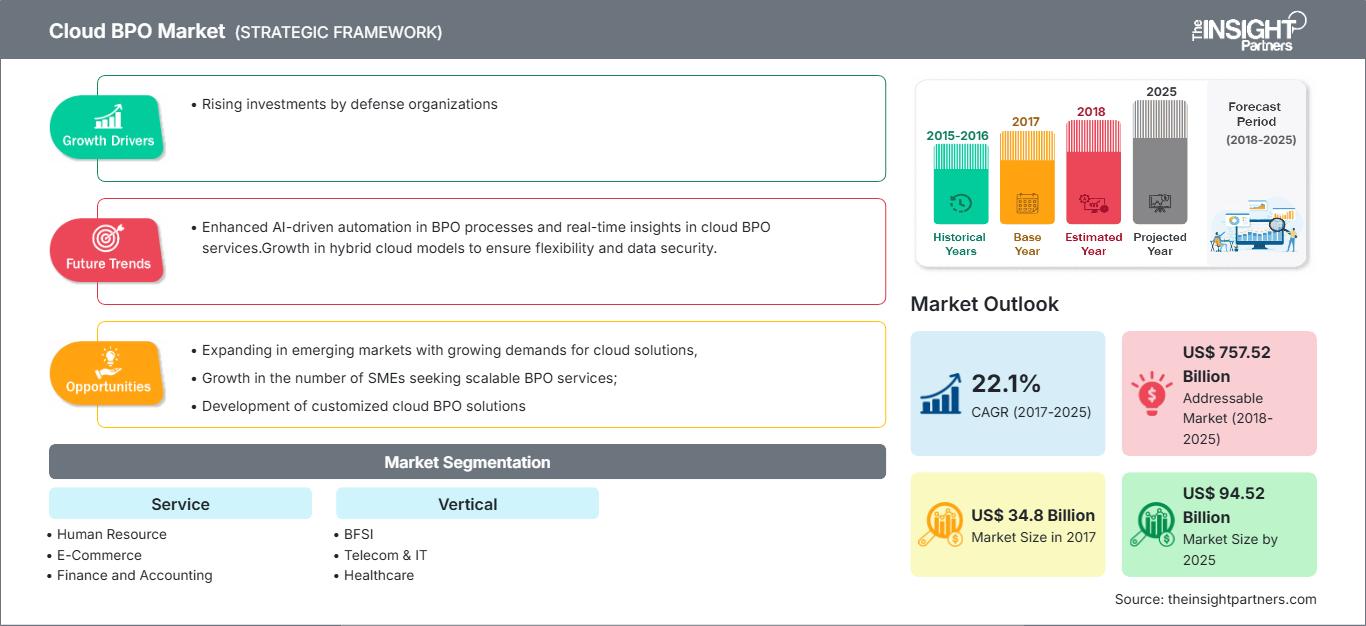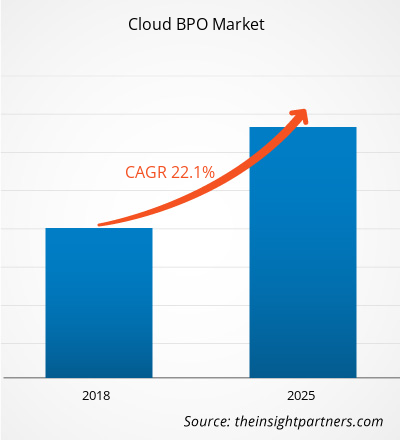Si stima che il mercato del Cloud BPO valga circa 81,36 miliardi di dollari nel 2025. Si prevede che raggiungerà circa 211,52 miliardi di dollari entro il 2034, registrando un CAGR dell'11,2% nel periodo 2026-2034.
Analisi di mercato del mercato Cloud BPO
Le previsioni di mercato del Cloud BPO indicano una forte crescita, dovuta all'adozione diffusa del cloud computing nei servizi di business process outsourcing (BPO), alla riduzione dei costi operativi e alla maggiore agilità, nonché alla capacità dei modelli basati su cloud di gestire flussi di lavoro su larga scala e ad alta intensità di dati. Il Cloud BPO consente ai fornitori di servizi di outsourcing di ridurre i costi dell'infrastruttura IT, accelerare i tempi di elaborazione dei dati e soddisfare le esigenze in continua evoluzione dei clienti con risorse cloud flessibili.
Panoramica del mercato Cloud BPO
L'outsourcing dei processi aziendali in cloud (cloud BPO) si riferisce all'esternalizzazione di servizi di processo aziendale (come risorse umane, operazioni di e-commerce, finanza e contabilità, assistenza clienti, vendite e marketing e altri processi di supporto) tramite infrastrutture e piattaforme basate su cloud, anziché tramite i tradizionali modelli di outsourcing on-premise o legacy. I vantaggi includono scalabilità, efficienza dei costi, riduzione del carico infrastrutturale e tempi di risposta più rapidi per i processi ad alta intensità di dati.
Poiché le aziende migrano sempre più le funzioni aziendali sul cloud e le esternalizzano a fornitori terzi di cloud BPO, il cloud BPO diventa un fattore chiave per la trasformazione digitale, l'agilità operativa e i modelli operativi globali.
Personalizza questo report in base alle tue esigenze
Riceverai la personalizzazione gratuita di qualsiasi report, incluse parti di questo report, analisi a livello nazionale, pacchetto dati Excel e potrai usufruire di fantastiche offerte e sconti per start-up e università.
Mercato Cloud BPO: approfondimenti strategici

-
Scopri le principali tendenze di mercato di questo rapporto.Questo campione GRATUITO includerà analisi dei dati, che spaziano dalle tendenze di mercato alle stime e alle previsioni.
Driver e opportunità del mercato Cloud BPO
Fattori trainanti del mercato:
- Crescente domanda di risparmio sui costi e agilità nei servizi esternalizzati: il vantaggio in termini di costi offerto dai servizi BPO cloud (investimenti infrastrutturali inferiori, maggiore scalabilità) ha un impatto significativo sulla decisione di abbandonare il BPO tradizionale.
- Crescente adozione del cloud computing in tutti i settori: con la diffusione del cloud computing, gli operatori BPO sfruttano il cloud per gestire processi ad alta intensità di dati e offrire tempi di risposta più rapidi.
- Necessità di modelli di outsourcing flessibili e scalabili: le organizzazioni cercano partner di outsourcing in grado di adattare dinamicamente la capacità, gestire i picchi e integrare rapidamente nuovi servizi; il BPO basato su cloud supporta questi requisiti.
Opportunità di mercato:
- Espansione nei mercati emergenti con crescita dell'outsourcing: regioni come Asia-Pacifico, America Latina, Medio Oriente e Africa presentano un potenziale di crescita per i servizi BPO cloud, poiché le aziende in queste regioni adottano il cloud ed esternalizzano le funzioni non essenziali.
- Integrazione di tecnologie avanzate (intelligenza artificiale, analisi) nelle offerte Cloud BPO: i fornitori di Cloud BPO possono differenziarsi integrando analisi, automazione e intelligenza artificiale nei servizi, migliorando così l'efficienza dei processi, l'accuratezza e la proposta di valore.
- Soluzioni BPO cloud specifiche per settore verticale: offrire servizi BPO cloud personalizzati per settori verticali specifici (ad esempio, BFSI, telecomunicazioni/IT, sanità) rappresenta un'opportunità per soddisfare esigenze specializzate e requisiti di conformità.
Analisi della segmentazione del rapporto di mercato Cloud BPO
Per servizio:
- Risorse umane
- Commercio elettronico
- Finanza e contabilità
- Assistenza clienti
- Vendite e marketing
Per verticale:
- BFSI
- Telecomunicazioni e IT
- Assistenza sanitaria
- Automobilistico
- Produzione
- Cibo e bevande
- Potenza ed energia
- Elettronica di consumo
Per geografia:
- America del Nord
- Europa
- Asia Pacifico
- Medio Oriente e Africa
- America meridionale e centrale
Approfondimenti regionali sul mercato Cloud BPO
Le tendenze e i fattori regionali che hanno influenzato il mercato del Cloud BPO durante il periodo di previsione sono stati ampiamente spiegati dagli analisti di The Insight Partners. Questa sezione analizza anche i segmenti e la geografia del mercato del Cloud BPO in Nord America, Europa, Asia-Pacifico, Medio Oriente e Africa, America Meridionale e Centrale.
Ambito del rapporto di mercato Cloud BPO
| Attributo del report | Dettagli |
|---|---|
| Dimensioni del mercato nel 2025 | 81,36 miliardi di dollari USA |
| Dimensioni del mercato entro il 2034 | 211,52 miliardi di dollari USA |
| CAGR globale (2026 - 2034) | 11,2% |
| Dati storici | 2021-2024 |
| Periodo di previsione | 2026-2034 |
| Segmenti coperti |
Per servizio
|
| Regioni e paesi coperti |
America del Nord
|
| Leader di mercato e profili aziendali chiave |
|
Densità degli operatori del mercato Cloud BPO: comprendere il suo impatto sulle dinamiche aziendali
Il mercato del Cloud BPO è in rapida crescita, trainato dalla crescente domanda degli utenti finali, dovuta a fattori quali l'evoluzione delle preferenze dei consumatori, i progressi tecnologici e una maggiore consapevolezza dei vantaggi del prodotto. Con l'aumento della domanda, le aziende stanno ampliando la propria offerta, innovando per soddisfare le esigenze dei consumatori e sfruttando le tendenze emergenti, alimentando ulteriormente la crescita del mercato.

- Ottieni una panoramica dei principali attori del mercato Cloud BPO
Analisi della quota di mercato del Cloud BPO per area geografica
America del Nord
- Quota di mercato: detiene una quota significativa grazie alla maturità del settore dell'outsourcing e alla rapida adozione del cloud.
- Fattori chiave: ampia base di contratti di outsourcing, elevata adozione di infrastrutture cloud, domanda di servizi BPO convenienti.
- Tendenze: passaggio a modelli BPO cloud-native, sfruttando l'automazione e l'analisi nei servizi BPO.
Europa
- Quota di mercato: quota sostanziale dovuta alla forte tradizione di esternalizzazione e alla spinta normativa verso modelli di esternalizzazione digitale.
- Fattori chiave: domanda di servizi di outsourcing basati su cloud conformi alle normative sulla protezione dei dati (ad esempio, GDPR), necessità di modelli di outsourcing multi-paese.
- Tendenze: crescita dei modelli BPO cloud nearshore, maggiore adozione del BPO cloud da parte delle medie imprese.
Asia Pacifico
- Quota di mercato: regione in più rapida crescita grazie all'espansione dei mercati di outsourcing (India, Filippine), alla crescente adozione del cloud e ai vantaggi in termini di costi.
- Fattori chiave: ampio bacino di fornitori di servizi BPO che migrano verso modelli cloud, crescita della domanda di outsourcing aziendale e iniziative governative a supporto dell'infrastruttura cloud.
- Tendenze: crescente penetrazione del cloud BPO tra le PMI, crescita dei centri cloud BPO multilingue e multi-sede.
America meridionale e centrale
- Quota di mercato: regione emergente per l'adozione del cloud BPO.
- Fattori chiave: domanda di soluzioni di outsourcing convenienti, crescita di cliniche private e centri specialistici (nel settore BPO sanitario) e partnership pubblico-private nell'outsourcing.
- Tendenze: ascesa dei centri BPO cloud in America Latina che offrono servizi multilingue al Nord America e all'Europa; crescita dell'outsourcing dell'assistenza clienti basato su cloud.
Medio Oriente e Africa
- Quota di mercato: mercato in via di sviluppo con forte potenziale di crescita per le implementazioni BPO cloud.
- Fattori chiave: strategie nazionali di e-governance, espansione del settore dell'outsourcing, sviluppo delle infrastrutture nel cloud e nei data center.
- Tendenze: adozione del cloud BPO per i servizi di back-office della pubblica amministrazione e del settore pubblico, aumento della domanda di outsourcing integrato con cloud e analisi.
Densità degli operatori del mercato Cloud BPO: comprendere il suo impatto sulle dinamiche aziendali
Il mercato del Cloud BPO è altamente competitivo a causa della presenza di importanti fornitori globali di outsourcing e integratori di servizi cloud, oltre ad operatori regionali e di nicchia. Questo contesto spinge i fornitori a differenziarsi attraverso:
- Integrazione perfetta dell'infrastruttura cloud con i modelli di fornitura dei servizi BPO
- Offerte BPO cloud scalabili e convenienti, pensate sia per le grandi aziende che per i clienti di medie dimensioni
- Utilizzo di automazione, analisi e intelligenza artificiale per migliorare l'efficienza dei processi, la precisione e i servizi a valore aggiunto
- Interoperabilità con i sistemi aziendali, conformità alla sicurezza dei dati e capacità di servire impronte di outsourcing multi-geografiche
Le principali aziende che operano nel mercato Cloud BPO includono:
- Firstsource Solutions Ltd.
- WNS (Holdings) Ltd.
- Infosys Ltd.
- HCL Technologies Ltd.
- Genpact Ltd.
- Capgemini SE
- Atos SE
- Tata Consultancy Services Ltd.
- Accenture PLC
- IBM Corporation
Altre aziende analizzate nel corso della ricerca:
- HP Inc. / Hewlett Packard Enterprise
- EXL Service Holdings, Inc.
- CGI Inc.
- Sutherland Global Services, Inc.
- Tech Mahindra Limited
- Concentrix Corporation
- Teleperformance SE
- Wipro Limited
- Cognizant Technology Solutions Corporation
- Fujitsu Ltd.
Notizie e sviluppi recenti
- L'elevata adozione del cloud computing in diverse regioni offre ai fornitori di servizi BPO cloud notevoli opportunità di aumentare la quota di mercato.
- Le preoccupazioni relative alla sicurezza dei dati (violazione dei dati, iniezione di malware, ransomware, denial-of-service) rimangono una sfida fondamentale con l'espansione del cloud BPO.
Copertura del rapporto e risultati finali
Il rapporto “Cloud BPO Market – Dimensioni e previsioni (2021-2034)” fornisce un’analisi dettagliata che copre:
- Dimensioni e previsioni del mercato Cloud BPO a livello globale, regionale e nazionale per tutti i segmenti di mercato chiave coperti dall'ambito
- Tendenze del mercato Cloud BPO, nonché dinamiche di mercato quali fattori trainanti, vincoli e opportunità chiave
- Analisi PEST e SWOT dettagliate
- Analisi del mercato Cloud BPO che copre le principali tendenze del mercato, il quadro globale e regionale, i principali attori, le normative e i recenti sviluppi del mercato
- Analisi del panorama industriale e della concorrenza che copre la concentrazione del mercato, l'analisi della mappa termica, i principali attori e gli sviluppi recenti nel mercato Cloud BPO
- Profili aziendali dettagliati
- Analisi storica (2 anni), anno base, previsione (7 anni) con CAGR
- Analisi PEST e SWOT
- Valore/volume delle dimensioni del mercato - Globale, Regionale, Nazionale
- Industria e panorama competitivo
- Set di dati Excel
Report recenti
Testimonianze
Motivo dell'acquisto
- Processo decisionale informato
- Comprensione delle dinamiche di mercato
- Analisi competitiva
- Analisi dei clienti
- Previsioni di mercato
- Mitigazione del rischio
- Pianificazione strategica
- Giustificazione degli investimenti
- Identificazione dei mercati emergenti
- Miglioramento delle strategie di marketing
- Aumento dell'efficienza operativa
- Allineamento alle tendenze normative






















 Ottieni un campione gratuito per - Mercato BPO cloud
Ottieni un campione gratuito per - Mercato BPO cloud